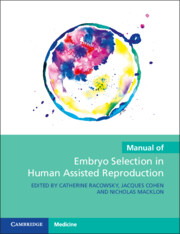Book contents
- Manual of Embryo Selection in Human Assisted Reproduction
- Manual of Embryo Selection in Human Assisted Reproduction
- Copyright page
- Contents
- Contributors
- Preface
- Chapter 1 Introduction
- Chapter 2 Embryo Developmental Programming
- Chapter 3 Embryo–Maternal Interactions
- Chapter 4 The Sperm’s Role in Embryo Development
- Chapter 5 The Oocyte’s Role in Embryo Development
- Chapter 6 The Laboratory’s Role in Embryo Development
- Chapter 7 Handling of Gametes and Embryos
- Chapter 8 Noninvasive Morphological Selection of Oocytes
- Chapter 9 Prospects for Bioenergetics for Embryo Selection
- Chapter 10 Static Morphological Assessment for Embryo Selection
- Chapter 11 Dynamic Morphological Assessment for Embryo Selection
- Chapter 12 Noninvasive Analysis of Embryo Nutrient Utilization for Embryo Selection
- Chapter 13 Genomics for Embryo Selection
- Chapter 14 Biopsy Techniques from Polar Body to Blastocyst
- Chapter 15 Cell-Free DNA Analysis for PGT-A
- Chapter 16 What Science May Come for Embryo Selection?
- Epilogue
- Index
- References
Chapter 7 - Handling of Gametes and Embryos
Published online by Cambridge University Press: 26 April 2023
- Manual of Embryo Selection in Human Assisted Reproduction
- Manual of Embryo Selection in Human Assisted Reproduction
- Copyright page
- Contents
- Contributors
- Preface
- Chapter 1 Introduction
- Chapter 2 Embryo Developmental Programming
- Chapter 3 Embryo–Maternal Interactions
- Chapter 4 The Sperm’s Role in Embryo Development
- Chapter 5 The Oocyte’s Role in Embryo Development
- Chapter 6 The Laboratory’s Role in Embryo Development
- Chapter 7 Handling of Gametes and Embryos
- Chapter 8 Noninvasive Morphological Selection of Oocytes
- Chapter 9 Prospects for Bioenergetics for Embryo Selection
- Chapter 10 Static Morphological Assessment for Embryo Selection
- Chapter 11 Dynamic Morphological Assessment for Embryo Selection
- Chapter 12 Noninvasive Analysis of Embryo Nutrient Utilization for Embryo Selection
- Chapter 13 Genomics for Embryo Selection
- Chapter 14 Biopsy Techniques from Polar Body to Blastocyst
- Chapter 15 Cell-Free DNA Analysis for PGT-A
- Chapter 16 What Science May Come for Embryo Selection?
- Epilogue
- Index
- References
Summary
This chapter provides an overview of the laboratory systems required for effective handling and processing of spermatozoa, oocytes and embryos for ART. These systems include the laboratory environment, and management of exposure to volatile organic compounds, as well as the culture environment, including temperature, pH, CO2 and O2, osmolarity, culture medium, and contact materials. Other considerations in effective gamete and handling, such as sample identification and witnessing, are also covered.
- Type
- Chapter
- Information
- Publisher: Cambridge University PressPrint publication year: 2023



